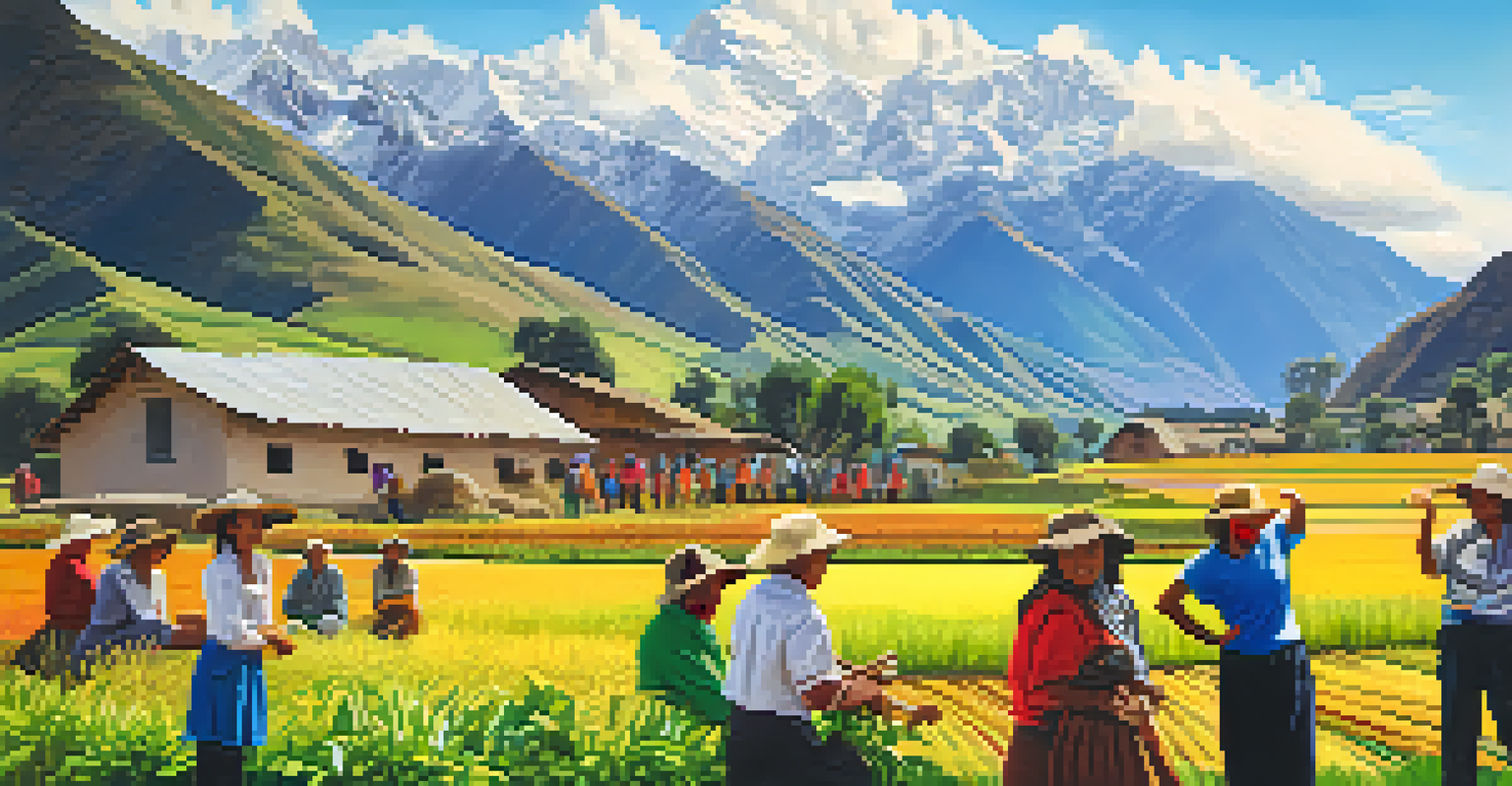The Importance of Water Conservation in Ecotourism in Peru

Understanding Ecotourism and Its Impact on Peru
Ecotourism is more than just a travel trend; it's a way to explore nature responsibly. In Peru, this means experiencing breathtaking landscapes, from the Andes to the Amazon, while preserving the environment. By attracting tourists who value sustainability, ecotourism can help protect the rich biodiversity that Peru is known for. However, this growth in tourism comes with its own set of challenges, particularly when it comes to managing natural resources like water.
In every walk with nature one receives far more than he seeks.
Peru's diverse ecosystems are often fragile, and excessive water use can threaten their sustainability. Tourists flock to sites like Machu Picchu and the Sacred Valley, which puts pressure on local water supplies. This is where the concept of water conservation becomes vital; it ensures that these resources can support both the environment and the communities that rely on them. Sustainable practices in tourism can help preserve these precious ecosystems for future generations.
Ultimately, understanding the relationship between ecotourism and environmental conservation is crucial for Peru's future. As travelers become more conscious about their impact, they can contribute to preserving the regions they visit. By promoting ecotourism that prioritizes water conservation, Peru can position itself as a leader in sustainable travel, balancing economic growth with environmental stewardship.
The Water Crisis: Challenges Facing Peru's Ecosystems
Peru is facing significant water challenges, particularly due to climate change and deforestation. Regions like the Andes are experiencing shifts in weather patterns, leading to irregular rainfall and diminishing glaciers. This not only affects water availability for local populations but also impacts the natural habitats that ecotourism relies on. The delicate balance of these ecosystems can easily be disrupted, making conservation efforts more urgent than ever.

In areas frequented by tourists, the demand for water can increase dramatically. Hotels, restaurants, and tour operators often utilize extensive water resources for their services, sometimes at the expense of local communities. This competition for water can lead to conflicts and exacerbate existing problems, making it crucial for the tourism industry to adopt sustainable practices. By recognizing the importance of water conservation, stakeholders can work towards solutions that benefit both the environment and the economy.
Ecotourism Benefits Peru's Biodiversity
Ecotourism in Peru fosters sustainable travel practices that help protect the country's rich biodiversity while attracting environmentally conscious tourists.
Addressing the water crisis requires a collaborative effort among government, businesses, and travelers. Implementing water-saving technologies and promoting responsible water use can make a significant difference. As ecotourism continues to grow in Peru, it is essential that all parties involved commit to practices that protect water resources and support the ecosystems that draw visitors from around the world.
The Role of Local Communities in Water Conservation
Local communities are at the heart of ecotourism in Peru, and their involvement is crucial for effective water conservation. When communities are engaged in tourism, they can share their knowledge about sustainable practices and the importance of preserving natural resources. This grassroots approach not only empowers locals but also enriches the tourist experience by providing authentic cultural insights. Tourists who learn from locals often leave with a deeper appreciation for the environment.
The environment is where we all meet; where we all have a mutual interest; it is the one thing all of us share.
Moreover, community-led initiatives can lead to innovative solutions for water management. For instance, some villages have started implementing rainwater harvesting systems and promoting the use of eco-friendly technologies. These efforts not only ensure a reliable water supply but also inspire visitors to adopt similar practices in their own lives. The more tourists understand how their actions can impact the environment, the more likely they are to support conservation efforts.
By prioritizing local engagement in ecotourism, Peru can create a model for sustainable travel. This not only benefits the environment but also helps to uplift communities economically. When tourists feel connected to the places they visit and the people they meet, they are more likely to advocate for the preservation of those areas, making the cycle of conservation a collective effort.
Innovative Water Conservation Techniques in Tourism
Innovative water conservation techniques are becoming increasingly important in the ecotourism sector. For example, many eco-lodges in Peru now implement systems that recycle water and utilize rainwater harvesting. By reducing their overall water footprint, these establishments set a positive example for other businesses in the industry. Not only do these practices help the environment, but they can also reduce operational costs, making them a win-win for both nature and business.
Another effective technique is the use of water-efficient fixtures and appliances. Installing low-flow toilets and showerheads can significantly decrease water usage without sacrificing comfort. Educating staff and guests about responsible water use further amplifies these efforts. Small changes, such as encouraging guests to reuse towels or take shorter showers, can lead to substantial water savings over time.
Water Conservation is Crucial
The growing demand for water due to tourism highlights the urgent need for effective water conservation strategies to support local ecosystems and communities.
Implementing these innovative techniques not only conserves water but also enhances the overall experience for tourists. Visitors are increasingly drawn to places that prioritize sustainability, and eco-lodges that showcase their efforts can attract more guests. By making water conservation an integral part of their operations, tourism providers in Peru can contribute to a healthier environment while meeting the growing demand for responsible travel.
The Importance of Education in Water Conservation
Education plays a pivotal role in promoting water conservation within the ecotourism industry. By informing both staff and guests about the importance of sustainable practices, businesses can foster a culture of conservation. Workshops, guided tours, and informational materials can highlight the significance of preserving water resources, creating a more mindful tourism experience. When people understand the challenges faced by Peru's ecosystems, they're more likely to engage in responsible behavior.
Tour operators can also integrate educational components into their itineraries, allowing travelers to learn about local water issues firsthand. This could include visits to community-run water projects or discussions with local conservationists. Such experiences not only enhance the trip but also empower tourists to become advocates for water conservation in their own lives. Education is a powerful tool that can drive change on both local and global scales.
As travelers increasingly seek meaningful experiences, the demand for educational components in ecotourism is likely to grow. By prioritizing education around water conservation, Peru can set itself apart as a destination that values sustainability. This commitment not only benefits the environment but also enriches the traveler’s experience, making their visit more impactful.
Partnerships for Sustainable Water Management
Partnerships between government, NGOs, and businesses can drive impactful water conservation initiatives in Peru's ecotourism sector. These collaborations can pool resources and expertise to develop comprehensive water management strategies. For instance, local governments can work with eco-lodges to implement water-saving technologies and create awareness campaigns. Such partnerships can strengthen the overall sustainability of the tourism industry while benefiting local communities.
Additionally, NGOs often bring valuable knowledge and experience in conservation efforts. Their involvement can enhance the effectiveness of water management projects and ensure that they are culturally appropriate. By collaborating with local communities, these organizations can help tailor solutions that address specific water issues faced by various regions in Peru. This collective approach fosters resilience against environmental challenges and promotes sustainable development.
Community Involvement is Key
Engaging local communities in ecotourism empowers them to share sustainable practices and enriches the tourist experience through authentic cultural insights.
Ultimately, the success of these partnerships hinges on the commitment of all stakeholders involved. When businesses, governments, and communities work together towards a common goal, they can create a lasting impact on environmental conservation. By prioritizing sustainable water management, Peru can establish itself as a leader in ecotourism while safeguarding its precious natural resources.
The Future of Ecotourism and Water Conservation in Peru
The future of ecotourism in Peru is intricately linked to effective water conservation strategies. As the effects of climate change and population growth continue to strain water resources, the need for sustainable practices becomes even more critical. By prioritizing water conservation, Peru can ensure that its natural attractions remain vibrant and accessible for generations to come. This forward-thinking approach not only benefits the environment but also supports the local economy.
Moreover, as travelers become increasingly eco-conscious, they will likely seek out destinations that prioritize sustainability. By establishing itself as a leader in water conservation within the ecotourism sector, Peru can attract more visitors who are eager to support responsible travel. This trend presents a unique opportunity for the country to showcase its commitment to preserving its stunning landscapes and rich biodiversity.

In conclusion, the importance of water conservation in ecotourism cannot be overstated. It is essential for protecting Peru's delicate ecosystems and supporting the livelihoods of local communities. By embracing sustainable practices and fostering a culture of conservation, Peru can position itself as a shining example of how tourism can coexist harmoniously with nature. The journey towards a sustainable future begins with each of us, and together, we can make a difference.